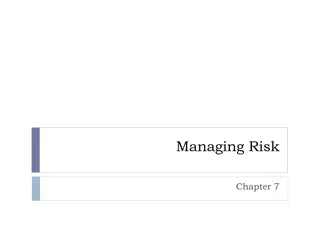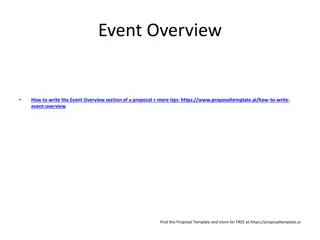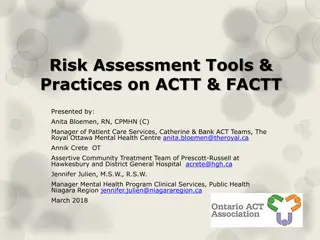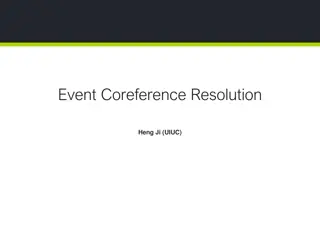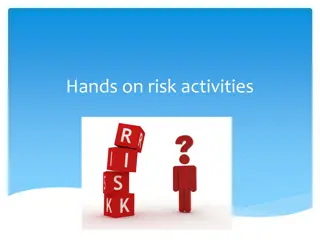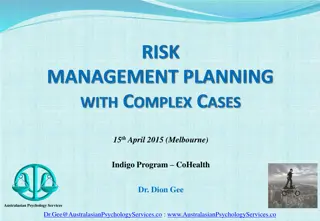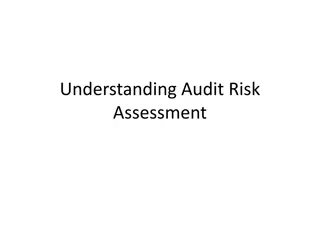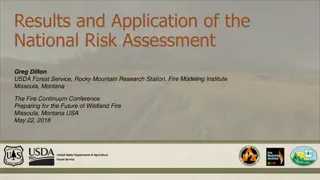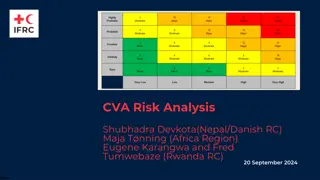Chlorpyrifos Science and Risk Assessment April 19-21, 2016 Event Overview
The event focused on Chlorpyrifos, featuring key presenters from Dow AgroSciences, George Mason University, and The Dow Chemical Company. Topics discussed included EPA proposals, data reliability, and regulatory impacts. The event highlighted the importance of data vetting before SAP proceedings and emphasized the potential consequences of proposed changes to Chlorpyrifos regulation.
Download Presentation

Please find below an Image/Link to download the presentation.
The content on the website is provided AS IS for your information and personal use only. It may not be sold, licensed, or shared on other websites without obtaining consent from the author. Download presentation by click this link. If you encounter any issues during the download, it is possible that the publisher has removed the file from their server.
E N D
Presentation Transcript
Chlorpyrifos Science and Risk Assessment April 19-21, 2016
Daland R. Juberg, PhD, ATS Dow AgroSciences Global Leader, Human Health Assessment 3 |
Jeff Driver, DrPH., DABT, M.T., C.L.S. Adjunct Faculty, George Mason University Principal, risksciences.net, LLC 4 |
Carol J. Burns, PhD, MPH, FACE The Dow Chemical Company Senior Epidemiologist 5 |
William Banner, MD, PhD, FAAP, FAACT, FACMT, FCCM Pediatric Medicine and Pediatric Toxicology Medical Director - Oklahoma Poison Control Center Attending Physician, Pediatric ICU, Baptist Integris Medical Center, Oklahoma City, OK 6 |
CHLORPYRIFOS SCIENCE AND RISK ASSESSMENT Daland R. Juberg, PhD., ATS Dow AgroSciences April 19-21, 2016
Personal Background Global Leader, Human Health Assessment MS (Env. Hlth Sci) and PhD (Toxicology) U. Michigan Fellow, Academy of Toxicological Sciences 24 Years of Applied, Regulatory Toxicology Experience 8 |
Important Concepts for Todays Discussion EPA proposal to change the PoD assumes the CCCEH are the best available data and could trigger elimination of chlorpyrifos Unprecedented and precedent-setting process that jeopardizes the established science-based regulatory process Impact goes beyond the discussion of chlorpyrifos before this SAP Over 40 major agricultural organizations joined together to express their concern Before SAP charge questions are addressed, there are basic assumptions (i.e., reliability of data) that need to be vetted > EPA recently responded to registrants that this SAP can consider reliability of relevant data and this is an integral part of the SAP s assessment 9 |
Purpose RBC ChEI PoD Dow AgroSciences Studies/Review Independent Reviews Current PoD Proposal 10 |
2012 SAP Conclusions on RBC ChEI as PoD The Panel concurs with the Agency s position that AChE data continue to be the strongest resource of data for deriving points of departure for chlorpyrifos. Thus, just as in the 2008 SAP, this Panel advises that the Agency continue to use AChE data at the most sensitive lifestages for dose-response analysis and deriving points of departure. 11 |
Global Views on Use of RBC ChEI as PoD WHO/FAO 1972 Joint Meeting on Pesticide Residues (JMPR) Recognized CPF as a cholinesterase inhibitor affecting this enzyme in brain or blood WHO 1999 The signs of acute intoxication with chlorpyrifos were consistent with cholinesterase inhibition and In long-term studies, inhibition of cholinesterase was again the main toxicological finding in all species. Canada 1969 Reference doses for various populations have been set based on no observed adverse effect levels for the most sensitive indicator of toxicity, namely acetylcholinesterase Australia 2000 Depression of cholinesterase activity appears to be the most sensitive toxicological endpoint for chlorpyrifos EFSA 2014 The experts agreed on the use of the red blood cell cholinesterase inhibition to derive the reference values 12 |
European Food Safety Authority (EFSA) EFSA review included the Columbia (CCCEH) cohort, Mt Sinai cohort, and UC Berkeley cohort and concluded the following: The epidemiology data are not sufficiently robust to support the hypothesis that CPF is a causal factor for neurodevelopmental effects. 13 |
DAS Science and Registration Review Primary registrant that has supported EPA reregistration and registration review all raw data submitted to EPA We take extra efforts, beyond required Agency requests, for scientific rigor and clarification Consistently have engaged external panels to vet claims relative to exposure and effects (Clegg and van Gemert, Albers et al., Eaton et al., Li et al., Prueitt et al, Mink et al;) 40+ years of science continues to support RBC ChEI as the biologically-relevant and protective PoD 14 |
DAS Submissions to USEPA EPA s Evaluation of the Toxicity Profile of Chlorpyrifos: September 9, 2008 Response to EPA s Chlorpyrifos Registration Review: May 18, 2009 Response to EPA s Preliminary Human Health Risk Assessment: October 5, 2011 Evaluation of Columbia University Epidemiology Study Claims Related to Brain Abnormalities and Pre-Natal Exposures to Chlorpyrifos: July 11, 2012 A Scientific Perspective on the Reliability and Utility of Information from Epidemiology Studies: November 12, 2013 Response to EPA s Revised Human Health Risk Assessment for Chlorpyrifos: April 29, 2015 Comments on EPA s Literature Review on Neurodevelopmental Effects & FQPA Safety Factor Determination for the Organophosphate Pesticides: December 22, 2015 EPA has not responded to these or other stakeholder comments 15 |
Expert Reviews on Animal/Human Data and Neurodevelopment Eaton et al. 2008. Review of the Toxicology of Chlorpyrifos with an Emphasis on Human Exposure and Neurodevelopment. Crit. Rev. Toxicol. S2:1-125 Li et al. 2012. Evaluation of Epidemiology and Animal Data for Risk Assessment: Chlorpyrifos Developmental Neurobehavioral Outcomes. J. Toxicol. Env. Health, Part B: Critical Reviews. 15:109-184. Prueitt et al., 2011. Hypothesis-Based Weight of Evidence Evaluation of the Neurodevelopmental Effects of Chlorpyrifos. Crit. Reviews in Toxicol. 41:822- 903. Li et al. 2012. Integration of Epidemiology and Animal Neurotoxicity Data for Risk Assessment. Neurotoxicol. 33:823-32. Mink et al., 2012. Potential Effects of Chlorpyrifos on Fetal Growth Outcomes: Implications for Risk Assessment. J. Toxicol. Env. Health, Part B. 15:281-316. 16 |
Prueitt et al (2011) Conclusions Based on an HBWoE analysis, we conclude that a causal association between chlorpyrifos exposure and neurodevelopmental effects in the absence of acetylcholinesterase inhibition in the brain is not plausible in humans, and the few positive associations observed in epidemiology studies are most likely attributable to alternative explanations. 17 |
Proposed Paradigm Shift Shift from 40+ years of data to single point measurement from one study DAS is not aware of significant new data that supports abruptly moving away from the RBC ChEI PoD A shift of this magnitude should be accompanied by reliability in all contributing scientific information/data animal, human, exposure Studies for regulatory decision-making should have a common standard including the need for the Agency to have access to underlying raw data (CCCEH data has not been made available) DAS is very concerned about the process and lack of time (11 business days), transparency, and scientific rigor that must underpin objective risk assessment 18 |
Former USEPA OPP Leadership Perspectives The totality of problems relating to the reliability of the reported findings on the Columbia cohort renders the study inappropriate for risk assessment. > Dr. Debra Edwards (2013) Former Director of EPA s Office of Pesticide Programs. It is my opinion that is not the best approach for EPA to use as a PoD for chlorpyrifos a benchmark dose calculated from the published summary data rather than from the underlying raw data. I submit this is a major vulnerability for the Agency. I have experienced first-hand the intense scrutiny to which EPA s risk assessment process is subject, even many years after its publication: I caution EPA against moving forward without the benefit of the raw data. > Dr. R. Schoeny (former Senior Science Advisor in EPA s Office of Science Policy in the ORD (Submitted to docket: EPA-HQ-OPP-2016-0062) 19 |
References to additional relevant comments submitted to the docket for the April 19-21 SAP Burns, C. 2015. Comments on EPA s Literature Review on Neurodevelopment Effects & FQPA Safety Factor Determination for the Organophosphate Pesticides (document posted in docket EPA-HQ-OPP-2010-0119). December 22, 2015. Submitted to docket: EPA-HQ-OPP-2016-0062. https://www.regulations.gov/#!documentDetail;D=EPA-HQ-OPP-2016-0062-0107 Banner, W. 2016. Comments to April 19-21 FIFRA Scientific Advisory Panel. Submitted to docket: EPA-HQ-OPP-2016-0062 Dow AgroSciences. 2016. Dow AgroSciences LLC s Request for EPA to (i) Explain its Reliance on Epidemiology Studies in the Face of Incomplete and Insufficient Raw Data and (ii) Reopen the Comment Periods for EPA s Revised Human Health Assessment for Chlorpyrifos and Proposed Rule to Revoke all Chlorpyrifos Tolerances. Letter to J. Housenger. March 30, 2016. Submitted to docket: EPA-HQ-OPP-2016-0062. https://www.regulations.gov/#!documentDetail;D=EPA-HQ-OPP-2016- 0062-0107 Dow AgroSciences. 2016. Dow AgroSciences LLC s Petition to Postpone the April 2016 FIFRA SAP. Letter to J. Housenger. April 4, 2016. Submitted to docket: EPA-HQ-OPP-2016-0062. https://www.regulations.gov/#!documentDetail;D=EPA-HQ- OPP-2016-0062-0106 Dow AgroSciences Additional Comments for the EPA s FIFRA Scientific Advisory Panel (SAP): Chlorpyrifos: Analysis of Biomonitoring Data (April 19-21) (April 15, 2016) (earlier comments dated April 8, 2016) Docket EPA-HQ-OPP-2016-0062. Dow AgroSciences (DAS). 2016. EPA s Precedent-Setting Proposal for a New POD for Chlorpyrifos is Not Based on Sound Science or Established Policy (Initial comments by Dow AgroSciences, LLC. April 8, 2016). Dow AgroSciences, LLC. Submitted to docket: EPA-HQ-OPP-2016-0062. Driver, J., J. Ross. 2016. Evaluation of Biomonitoring Data from Epidemiology Studies. Question 2 Uncertainties with Using Biomarker Data from CCCEH for the POD (Section 7.1). Risksciences.net, LLC. Submitted to docket: EPA-HQ-OPP-2016- 0062. Goodman, J., C.T. Loftus. 2016. Addressing Uncertainty in Epidemiology Used in the Chlorpyrifos Risk Assessment. Submitted to docket: EPA-HQ-OPP-2016-0062. Schoeny, R. 2016. Comments to April 19-21 FIFRA Scientific Advisory Panel. Submitted to docket: EPA-HQ-OPP-2016- 0062 20 |
Summary It is premature to consider a new PoD for chlorpyrifos until all issues regarding CCCEH epidemiology raw data are resolved and a thorough, transparent, and weight-of-evidence review is conducted. 40+ years of science continue to support RBC ChEI as the relevant and protective PoD, including protection against neurodevelopmental effects. No identifiable and replicated mode of action in either animals or humans has been demonstrated to support a relationship between exposure to chlorpyrifos and neurodevelopmental outcomes at the current regulatory standard. Numerous independent reviews and global regulatory agencies continue to consistently support RBC ChEI as a protective PoD, including protection against all toxicities, including neurodevelopmental. 21 |












